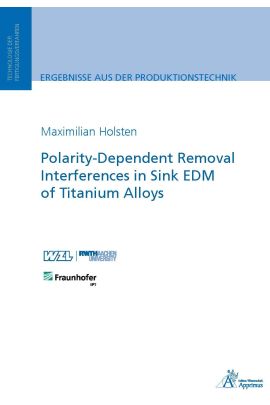Dieses E-Book können Sie hier herunterladen.
In the design of turbomachinery components, a significant effort is carried out regarding the optimization of efficiency. The increase in thermal efficiency particularly involves the introduction of high-performance alloys. Such alloys are for example titanium alloys. Sink electrical discharge machining (sink EDM) is a crucial manufacturing process for components due to its independence of machined material strengths; however, new materials require process design. Hence, research to understand and optimize the machining of titanium alloys is of great benefit to the industry in general.
A positive tool polarity is generally adopted in sink EDM to maximize material removal relative to tool wear. Sink EDM of α/β titanium alloys as Ti6Al4V is however atypical in that these materials necessitate a negative tool polarity. Adding to the intrigue are gamma titanium aluminides (γ-TiAl), which machine better under the conventional positive polarity. Established explanatory models of sink EDM fail in resolving the removal behavior – a need for fundamental research is given.
This thesis focuses on clarifying the phenomena behind this interesting behavior by investigating removal mechanisms over a range of relevant process conditions. The polarity-effect is demonstrated to arise from the polarity-dependent nature and extent of titanium carbide (TiC) formation on the workpiece surface, which significantly affects material removal mechanisms. An explanatory model, deduced from different experimental and numerical approaches, clarifies the influence of polarity to the formation mechanism of a TiC layer. With regard to monitoring of adverse layer formations, the measurement of acoustic emission (AE) is proven an appropriate concept. A correlation of the AE signal to process forces is even established, which may be crucial to determine the deflection of thin electrodes in EDM. Finally, the knowledge acquired is applied and enhanced in comprehensive process design, that also involves the machining of additively manufactured γ-TiAl. The study reveals the beneficial behavior of the fine microstructure relative to the resulting surface integrity. As a result, this thesis delivers a model-based concept for process design with respect to the adequate choice of tool polarity during machining of titanium alloys.
| Autor | Holsten, Maximilian |
|---|---|
| Lieferzeit | 3-4 Tage |
| Gewicht | 0 kg |
| Erscheinungsdatum | 31.12.2018 |
Technologie der Fertigungsverfahren
Polarity-Dependent Removal Interferences in Sink EDM of Titanium Alloys (E-Book)
Kurzbeschreibung
Dieses E-Book können Sie hier herunterladen.
Bei der Auslegung von Turboarbeitsmaschinen ist es ein grundlegendes Ziel, die Effizienz zu steigern. Eine Steigerung des thermischen Wirkungsgrades eines Triebwerks bedingt unter anderem den Einsatz moderner Hochleistungswerkstoffe wie zum Beispiel Titanlegierungen. Das funkenerosive Senken ist aufgrund seiner Unabhängigkeit bearbeiteter Bauteile eine Schlüsseltechnologie im Triebwerksbau. Die Einführung neuer Werkstoffe bedingt jedoch Wissen zur Prozessauslegung. Daher ist die wissenschaftliche Erforschung der Funkenerosion von Titanlegierungen von großer Bedeutung für die industrielle Praxis.

